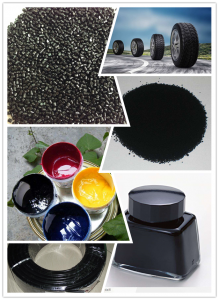CARBON BLACK
PROPERTIES
Traditionally, carbon black has been used as a reinforcing agent in tires. Today, because of its unique properties, the uses of carbon black have expanded to include pigmentation, ultraviolet (UV) stabilization and conductive agents in a variety of everyday and specialty high performance products.
APPLICATIONS:
Tires and Industrial Rubber Products: Carbon black is added to rubber as both a filler and as a strengthening or reinforcing agent. For various types of tires, it is used in inner liners, carcasses, sidewalls and treads utilizing different types based on specific performance requirements. Carbon black is also used in many molded and extruded industrial rubber products, such as belts, hoses, gaskets, diaphragms, vibration isolation devices, bushings, air springs, chassis bumpers, and multiple types of pads, boots, wiper blades, fascia, conveyor wheels, and grommets.
Plastics: Carbon blacks are now widely used for conductive packaging, films, fibers, moldings, pipes and semi-conductive cable compounds in products such as refuse sacks, industrial bags, photographic containers, agriculture mulch film, stretch wrap, and thermoplastic molding applications for automotive, electrical/electronics, household appliances and blow-molded containers.
Electrostatic Discharge (ESD) Compounds: Carbon blacks are carefully designed to transform electrical characteristics from insulating to conductive in products such as electronics packaging, safety applications, and automotive parts.
High Performance Coatings: Carbon blacks provide pigmentation, conductivity, and UV protection for a number of coating applications including automotive (primer basecoats and clearcoats), marine, aerospace, decorative, wood, and industrial coatings.
Toners and Printing Inks: Carbon blacks enhance formulations and deliver broad flexibility in meeting specific color requirements.
• HAF-N330
• GPF-N660
• FEF-N550
• SRF-N774
• IAFS-N220
• MT BLACK

